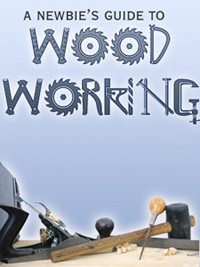 License Type: Private Label Rights
License Type: Private Label Rights  File Size: 1,544 KB
File Size: 1,544 KB File Type: ZIP
File Type: ZIP
 SKU: 23125
SKU: 23125  Shipping: Online Download
Shipping: Online Download
Ebook Sample Content Preview:
One of the first hurdles a new woodworker must get past is the fear of messing up a project, and one of the best ways to tackle that apprehension is to simply “think outside the box”. Most beginners decide to start with something simple (but may not know which projects have simple joinery) and then set out on a search for preprinted plans to make such- and-such.
It can become frustrating if personal help is not available. There are several ways to cure this, but here is one that has worked for many: forget other people's plans. Design what you need yourself. It isn't as hard as one might think, because there are always some kinds of limiting parameters to start with.
A bookshelf must be 10” deep so the books will slide into it, and shelf spacing will match the height of your tallest books, plus one inch for finger room. A curio shelf will be sized by the space available to accommodate it, or by the objects to be displayed on it. Bed frames should fit standard mattress sizes, and doors…well, there are your openings to measure.
The point is, don't be afraid to begin these projects on your own. There is a vast knowledge base of woodworking advice available in printed matter and online. If the project doesn't turn out as you'd planned, you can always start over, and you will have learned a great deal along the way. We often learn more from our mistakes in working wood than from easy successes.
Why not try to design your own piece? Drawing ideas out freehand on paper is helpful. What if it were this way, or that way? Hand sketches will show you how ideas can come together, or clash with each other. Then, if you know the shelf must fit a space five feet high overall, the number of shelves to include will be dictated by the height of the items to be stored. Heavy or larger items (or spaces) usually go near the bottom of a unit, to anchor it physically as well as to the eye when viewed from across a room. Spaces can also be broken up and not continuous across the entire front.
Designs can also be planned based on what wood a woodworker may have available. If you have several 2x4s sitting around, an Early American or pinewood look may be called for. Be certain to carefully square up any stock. Construction castoffs are easily ripped to usable dimensions on a table saw, but learn the safety procedures for your machine before trying to rip long boards.
Designing your own project can also mean adapting someone else's plan to your own use. It's quite common for a woodworker to see the ideal blanket chest, sofa table or display case, and then think “But I want mine to be…” and redesign the entire structure. Don't be afraid to trust your instincts and be innovative in making a piece. Educate yourself; ask questions of others on woodworking forums or at clubs and guilds. You'll soon surprise yourself with how much you can do.








